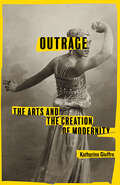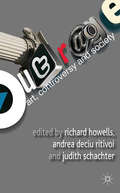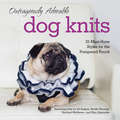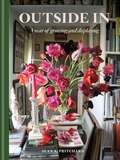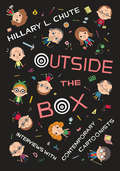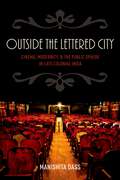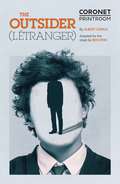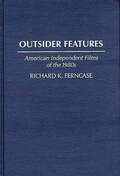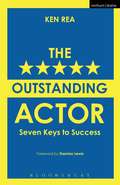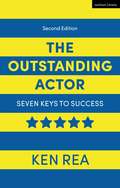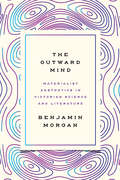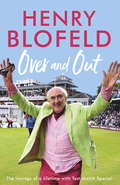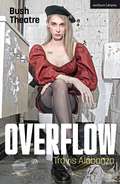- Table View
- List View
Outrage: The Arts and the Creation of Modernity
by Katherine GiuffreA cultural revolution in England, France, and the United States beginning during the time of the industrial and political revolutions helped usher in modernity. This cultural revolution worked alongside the better documented political and economic revolutions to usher in the modern era of continuous revolution. Focusing on the period between 1847 and 1937, the book examines in depth six of the cultural "battles" that were key parts of this revolution: the novels of the Brontë sisters, the paintings of the Impressionists, the poetry of Emily Dickinson, the Ballets Russes production of Le Sacre du printemps, James Joyce's Ulysses, and Zora Neale Hurston's Their Eyes Were Watching God. Using contemporaneous reviews in the press as well as other historical material, we can see that these now-canonical works provoked outrage at the time of their release because they addressed critical points of social upheaval and transformation in ways that engaged broad audiences with subversive messages. This framework allows us to understand and navigate the cultural debates that play such an important role in 21st century politics.
Outrage: The Arts and the Creation of Modernity
by Katherine GiuffreA cultural revolution in England, France, and the United States beginning during the time of the industrial and political revolutions helped usher in modernity. This cultural revolution worked alongside the better documented political and economic revolutions to usher in the modern era of continuous revolution. Focusing on the period between 1847 and 1937, the book examines in depth six of the cultural "battles" that were key parts of this revolution: the novels of the Brontë sisters, the paintings of the Impressionists, the poetry of Emily Dickinson, the Ballets Russes production of Le Sacre du printemps, James Joyce's Ulysses, and Zora Neale Hurston's Their Eyes Were Watching God. Using contemporaneous reviews in the press as well as other historical material, we can see that these now-canonical works provoked outrage at the time of their release because they addressed critical points of social upheaval and transformation in ways that engaged broad audiences with subversive messages. This framework allows us to understand and navigate the cultural debates that play such an important role in 21st century politics.
Outrage: Art, Controversy, and Society
by Richard Howells, Andreea Deciu Ritivoi and Judith SchachterA study of controversy in the arts, and the extent to which such controversies are socially rather than just aesthetically conditioned. The collection pays special attention to the vested interests and the social dynamics involved, including class, religion, culture, and - above all - power.
Outrageously Adorable Dog Knits: 25 Must-have Styles For The Pampered Pooch
by Caitlin Doyle Jill Bulgan Noelle Woosley Rachael Matthews Max AlexanderDogs can’t knit. But they sure can wear it well.
Outside In: A Year of Growing & Displaying
by Sean A Pritchard'Inventive, considered, and thoughtful design.' House & GardenIn his debut book, garden designer Sean A Pritchard shows you how to plan a garden so that every month of the year there's something to bring indoors and display in an engaging way. From the cheery joy of early spring daffodils to the velvety richness of late-summer dahlias, the deep glow of golden autumn leaves to the optimism of late-winter catkins, Sean explains how to grow, harvest, and arrange an abundance of nature's treasure - no matter the size of your plot or your level of horticultural experience.
Outside the Box: Interviews with Contemporary Cartoonists
by Hillary L. ChuteWe are living in a golden age of cartoon art. Never before has graphic storytelling been so prominent or garnered such respect: critics and readers alike agree that contemporary cartoonists are creating some of the most innovative and exciting work in all the arts. For nearly a decade Hillary L. Chute has been sitting down for extensive interviews with the leading figures in comics, and with Outside the Box she offers fans a chance to share her ringside seat. Chute’s in-depth discussions with twelve of the most prominent and accomplished artists and writers in comics today reveal a creative community that is richly interconnected yet fiercely independent, its members sharing many interests and approaches while working with wildly different styles and themes. Chute’s subjects run the gamut of contemporary comics practice, from underground pioneers like Art Spiegelman and Lynda Barry, to the analytic work of Scott McCloud, the journalism of Joe Sacco, and the extended narratives of Alison Bechdel, Charles Burns, and more. They reflect on their experience and innovations, the influence of peers and mentors, the reception of their art and the growth of critical attention, and the crucial place of print amid the encroachment of the digital age. Beautifully illustrated in full-color, and featuring three never-before-published interviews—including the first published conversation between Art Spiegelman and Chris Ware—Outside the Box will be a landmark volume, a close-up account of the rise of graphic storytelling and a testament to its vibrant creativity.
Outside the Box: Interviews with Contemporary Cartoonists
by Hillary L. ChuteWe are living in a golden age of cartoon art. Never before has graphic storytelling been so prominent or garnered such respect: critics and readers alike agree that contemporary cartoonists are creating some of the most innovative and exciting work in all the arts. For nearly a decade Hillary L. Chute has been sitting down for extensive interviews with the leading figures in comics, and with Outside the Box she offers fans a chance to share her ringside seat. Chute’s in-depth discussions with twelve of the most prominent and accomplished artists and writers in comics today reveal a creative community that is richly interconnected yet fiercely independent, its members sharing many interests and approaches while working with wildly different styles and themes. Chute’s subjects run the gamut of contemporary comics practice, from underground pioneers like Art Spiegelman and Lynda Barry, to the analytic work of Scott McCloud, the journalism of Joe Sacco, and the extended narratives of Alison Bechdel, Charles Burns, and more. They reflect on their experience and innovations, the influence of peers and mentors, the reception of their art and the growth of critical attention, and the crucial place of print amid the encroachment of the digital age. Beautifully illustrated in full-color, and featuring three never-before-published interviews—including the first published conversation between Art Spiegelman and Chris Ware—Outside the Box will be a landmark volume, a close-up account of the rise of graphic storytelling and a testament to its vibrant creativity.
Outside the Box: Interviews with Contemporary Cartoonists
by Hillary L. ChuteWe are living in a golden age of cartoon art. Never before has graphic storytelling been so prominent or garnered such respect: critics and readers alike agree that contemporary cartoonists are creating some of the most innovative and exciting work in all the arts. For nearly a decade Hillary L. Chute has been sitting down for extensive interviews with the leading figures in comics, and with Outside the Box she offers fans a chance to share her ringside seat. Chute’s in-depth discussions with twelve of the most prominent and accomplished artists and writers in comics today reveal a creative community that is richly interconnected yet fiercely independent, its members sharing many interests and approaches while working with wildly different styles and themes. Chute’s subjects run the gamut of contemporary comics practice, from underground pioneers like Art Spiegelman and Lynda Barry, to the analytic work of Scott McCloud, the journalism of Joe Sacco, and the extended narratives of Alison Bechdel, Charles Burns, and more. They reflect on their experience and innovations, the influence of peers and mentors, the reception of their art and the growth of critical attention, and the crucial place of print amid the encroachment of the digital age. Beautifully illustrated in full-color, and featuring three never-before-published interviews—including the first published conversation between Art Spiegelman and Chris Ware—Outside the Box will be a landmark volume, a close-up account of the rise of graphic storytelling and a testament to its vibrant creativity.
Outside the Box: Interviews with Contemporary Cartoonists
by Hillary L. ChuteWe are living in a golden age of cartoon art. Never before has graphic storytelling been so prominent or garnered such respect: critics and readers alike agree that contemporary cartoonists are creating some of the most innovative and exciting work in all the arts. For nearly a decade Hillary L. Chute has been sitting down for extensive interviews with the leading figures in comics, and with Outside the Box she offers fans a chance to share her ringside seat. Chute’s in-depth discussions with twelve of the most prominent and accomplished artists and writers in comics today reveal a creative community that is richly interconnected yet fiercely independent, its members sharing many interests and approaches while working with wildly different styles and themes. Chute’s subjects run the gamut of contemporary comics practice, from underground pioneers like Art Spiegelman and Lynda Barry, to the analytic work of Scott McCloud, the journalism of Joe Sacco, and the extended narratives of Alison Bechdel, Charles Burns, and more. They reflect on their experience and innovations, the influence of peers and mentors, the reception of their art and the growth of critical attention, and the crucial place of print amid the encroachment of the digital age. Beautifully illustrated in full-color, and featuring three never-before-published interviews—including the first published conversation between Art Spiegelman and Chris Ware—Outside the Box will be a landmark volume, a close-up account of the rise of graphic storytelling and a testament to its vibrant creativity.
Outside the Lettered City: Cinema, Modernity, and the Public Sphere in Late Colonial India
by Manishita DassOutside the Lettered City traces how middle-class Indians responded to the rise of the cinema as a popular form of mass entertainment in early 20th century India, focusing on their preoccupation with the mass public made visible by the cinema and with the cinema's role as a public sphere and a mass medium of modernity. It draws on archival research to uncover aspirations and anxieties about the new medium, which opened up tantalizing possibilities for nationalist mobilization on the one hand, and troubling challenges to the cultural authority of Indian elites on the other. Using case-studies drawn from the film cultures of Bombay and Kolkata, it demonstrates how discourses about the cinematic public dovetailed into discourses about a national public, giving rise to considerable excitement about cinema's potential to democratize the public sphere beyond the limits of print-literate culture, as well as to deepening anxieties about cultural degeneration. The case-studies also reveal that early twentieth century discourses about the cinema contain traces of a formative tension in Indian public culture, between visions of a deliberative public and spectres of the unruly masses.
OUTSIDE THE LETTERED CITY C: Cinema, Modernity, and the Public Sphere in Late Colonial India
by Manishita DassOutside the Lettered City traces how middle-class Indians responded to the rise of the cinema as a popular form of mass entertainment in early 20th century India, focusing on their preoccupation with the mass public made visible by the cinema and with the cinema's role as a public sphere and a mass medium of modernity. It draws on archival research to uncover aspirations and anxieties about the new medium, which opened up tantalizing possibilities for nationalist mobilization on the one hand, and troubling challenges to the cultural authority of Indian elites on the other. Using case-studies drawn from the film cultures of Bombay and Kolkata, it demonstrates how discourses about the cinematic public dovetailed into discourses about a national public, giving rise to considerable excitement about cinema's potential to democratize the public sphere beyond the limits of print-literate culture, as well as to deepening anxieties about cultural degeneration. The case-studies also reveal that early twentieth century discourses about the cinema contain traces of a formative tension in Indian public culture, between visions of a deliberative public and spectres of the unruly masses.
The Outsider (Oberon Modern Plays)
by Albert CamusCamus’ sparse parable about the human condition is one of the great stories of the 20th Century, presented at the Coronet in its first major UK production.A faceless man who can no longer pretend, Mersault commits a senseless murder under the glare of the Algerian sun and is forced to confront the hypocrisy and injustice of society. In an age where we are being increasingly told what to feel, The Outsider is a blast of uncompromising honesty.Albert Camus, French novelist, essayist, philosopher and Nobel laureate, was one of the most influential thinkers of the 20th Century. Ben Okri, author of The Famished Road, is one of contemporary literature’s most important writers. This adaptation brings them together for a rare dramatisation of one of modern literature’s most celebrated works.
Outsider Features: American Independent Films of the 1980s (Contributions to the Study of Popular Culture)
by Richard K. FerncaseIn the early 1980s, serious American independent films including Stranger Than Paradise, Blood Simple, and She's Gotta Have It attracted ever-widening audiences, culminating with Steven Soderbergh's award-winning sex, lies, and videotape. This film, which won the Cannes Film Festival's top award and took more than $30 million at the box office in the United States alone, capped a remarkable decade for off-Hollywood filmmakers. Outsider Features takes an in-depth look at 10 of the most successful independent feature films made during this decade, from John Sayles's seminal and groundbreaking The Return of the Secaucus Seven to Michael Moore's wry and irreverent Roger & Me, the most lucrative non-music documentary ever made. Outsider Features offers accounts of the genesis of each film, complete synopses and critical analyses, and biographies of each filmmaker.
The Outstanding Actor: Seven Keys to Success (Performance Books)
by Ken ReaDrawing on Ken Rea's 30 years' teaching experience and research, as well as interviews with top actors and directors, The Outstanding Actor identifies seven key qualities that the most successful actors manifest, along with practical exercises that help nurture those qualities. Featuring contributions and insights from Ewan McGregor, Jude Law, Judi Dench, Al Pacino and many more, The Outstanding Actor gives you techniques that you can immediately put into practice in rehearsals, classes or private preparation. It also shows you how to increase the chances of having a more successful career. 'Ken taught us to be dangerous, to abandon any sense of failure and to take risks – that's where to find creativity. A lesson we can never stop learning.' Orlando Bloom 'The classes with Ken at Guildhall, I consider to be the most important part of the acting training. They are exercises in patience, unpredictability and encouraging students to make utter fools of themselves – vital for any actor embarking on a life in the profession.' Michelle Dockery 'Ken's classes were some of the most interesting that I was lucky enough to attend at drama school. He opened the mind to what acting could be.' Ewan McGregor Includes a foreword by Damian Lewis.
The Outstanding Actor: Seven Keys to Success
by Ken ReaDrawing on Ken Rea's 35 years' teaching experience and research, as well as interviews with top actors and directors, The Outstanding Actor identifies seven key qualities that the most successful actors manifest, along with practical exercises that help nurture those qualities and videos to demonstrate them. Featuring contributions and insights from Ewan McGregor, Jude Law, Judi Dench, Al Pacino, Lily James, Rufus Norris and many more, The Outstanding Actor gives you techniques that you can immediately put into practice in rehearsals, classes or private preparation. It also shows you how to increase the chances of having a more successful career. This new edition covers topical issues such as the #MeToo movement, gender balance and race issues, and how these affect working conditions and careers. There are also brand new links to video resources that bring the valuable exercises to life. The book also includes forewords by Damian Lewis and Lily James.
The Outstanding Actor: Seven Keys to Success (Performance Bks.)
by Ken ReaDrawing on Ken Rea's 35 years' teaching experience and research, as well as interviews with top actors and directors, The Outstanding Actor identifies seven key qualities that the most successful actors manifest, along with practical exercises that help nurture those qualities and videos to demonstrate them. Featuring contributions and insights from Ewan McGregor, Jude Law, Judi Dench, Al Pacino, Lily James, Rufus Norris and many more, The Outstanding Actor gives you techniques that you can immediately put into practice in rehearsals, classes or private preparation. It also shows you how to increase the chances of having a more successful career. This new edition covers topical issues such as the #MeToo movement, gender balance and race issues, and how these affect working conditions and careers. There are also brand new links to video resources that bring the valuable exercises to life. The book also includes forewords by Damian Lewis and Lily James.
The Outward Mind: Materialist Aesthetics in Victorian Science and Literature
by Benjamin MorganThough underexplored in contemporary scholarship, the Victorian attempts to turn aesthetics into a science remain one of the most fascinating aspects of that era. In The Outward Mind, Benjamin Morgan approaches this period of innovation as an important origin point for current attempts to understand art or beauty using the tools of the sciences. Moving chronologically from natural theology in the early nineteenth century to laboratory psychology in the early twentieth, Morgan draws on little-known archives of Victorian intellectuals such as William Morris, Walter Pater, John Ruskin, and others to argue that scientific studies of mind and emotion transformed the way writers and artists understood the experience of beauty and effectively redescribed aesthetic judgment as a biological adaptation. Looking beyond the Victorian period to humanistic critical theory today, he also shows how the historical relationship between science and aesthetics could be a vital resource for rethinking key concepts in contemporary literary and cultural criticism, such as materialism, empathy, practice, and form. At a moment when the tumultuous relationship between the sciences and the humanities is the subject of ongoing debate, Morgan argues for the importance of understanding the arts and sciences as incontrovertibly intertwined.
The Outward Mind: Materialist Aesthetics in Victorian Science and Literature
by Benjamin MorganThough underexplored in contemporary scholarship, the Victorian attempts to turn aesthetics into a science remain one of the most fascinating aspects of that era. In The Outward Mind, Benjamin Morgan approaches this period of innovation as an important origin point for current attempts to understand art or beauty using the tools of the sciences. Moving chronologically from natural theology in the early nineteenth century to laboratory psychology in the early twentieth, Morgan draws on little-known archives of Victorian intellectuals such as William Morris, Walter Pater, John Ruskin, and others to argue that scientific studies of mind and emotion transformed the way writers and artists understood the experience of beauty and effectively redescribed aesthetic judgment as a biological adaptation. Looking beyond the Victorian period to humanistic critical theory today, he also shows how the historical relationship between science and aesthetics could be a vital resource for rethinking key concepts in contemporary literary and cultural criticism, such as materialism, empathy, practice, and form. At a moment when the tumultuous relationship between the sciences and the humanities is the subject of ongoing debate, Morgan argues for the importance of understanding the arts and sciences as incontrovertibly intertwined.
The Outward Mind: Materialist Aesthetics in Victorian Science and Literature
by Benjamin MorganThough underexplored in contemporary scholarship, the Victorian attempts to turn aesthetics into a science remain one of the most fascinating aspects of that era. In The Outward Mind, Benjamin Morgan approaches this period of innovation as an important origin point for current attempts to understand art or beauty using the tools of the sciences. Moving chronologically from natural theology in the early nineteenth century to laboratory psychology in the early twentieth, Morgan draws on little-known archives of Victorian intellectuals such as William Morris, Walter Pater, John Ruskin, and others to argue that scientific studies of mind and emotion transformed the way writers and artists understood the experience of beauty and effectively redescribed aesthetic judgment as a biological adaptation. Looking beyond the Victorian period to humanistic critical theory today, he also shows how the historical relationship between science and aesthetics could be a vital resource for rethinking key concepts in contemporary literary and cultural criticism, such as materialism, empathy, practice, and form. At a moment when the tumultuous relationship between the sciences and the humanities is the subject of ongoing debate, Morgan argues for the importance of understanding the arts and sciences as incontrovertibly intertwined.
The Outward Mind: Materialist Aesthetics in Victorian Science and Literature
by Benjamin MorganThough underexplored in contemporary scholarship, the Victorian attempts to turn aesthetics into a science remain one of the most fascinating aspects of that era. In The Outward Mind, Benjamin Morgan approaches this period of innovation as an important origin point for current attempts to understand art or beauty using the tools of the sciences. Moving chronologically from natural theology in the early nineteenth century to laboratory psychology in the early twentieth, Morgan draws on little-known archives of Victorian intellectuals such as William Morris, Walter Pater, John Ruskin, and others to argue that scientific studies of mind and emotion transformed the way writers and artists understood the experience of beauty and effectively redescribed aesthetic judgment as a biological adaptation. Looking beyond the Victorian period to humanistic critical theory today, he also shows how the historical relationship between science and aesthetics could be a vital resource for rethinking key concepts in contemporary literary and cultural criticism, such as materialism, empathy, practice, and form. At a moment when the tumultuous relationship between the sciences and the humanities is the subject of ongoing debate, Morgan argues for the importance of understanding the arts and sciences as incontrovertibly intertwined.
The Outward Mind: Materialist Aesthetics in Victorian Science and Literature
by Benjamin MorganThough underexplored in contemporary scholarship, the Victorian attempts to turn aesthetics into a science remain one of the most fascinating aspects of that era. In The Outward Mind, Benjamin Morgan approaches this period of innovation as an important origin point for current attempts to understand art or beauty using the tools of the sciences. Moving chronologically from natural theology in the early nineteenth century to laboratory psychology in the early twentieth, Morgan draws on little-known archives of Victorian intellectuals such as William Morris, Walter Pater, John Ruskin, and others to argue that scientific studies of mind and emotion transformed the way writers and artists understood the experience of beauty and effectively redescribed aesthetic judgment as a biological adaptation. Looking beyond the Victorian period to humanistic critical theory today, he also shows how the historical relationship between science and aesthetics could be a vital resource for rethinking key concepts in contemporary literary and cultural criticism, such as materialism, empathy, practice, and form. At a moment when the tumultuous relationship between the sciences and the humanities is the subject of ongoing debate, Morgan argues for the importance of understanding the arts and sciences as incontrovertibly intertwined.
The Outward Mind: Materialist Aesthetics in Victorian Science and Literature
by Benjamin MorganThough underexplored in contemporary scholarship, the Victorian attempts to turn aesthetics into a science remain one of the most fascinating aspects of that era. In The Outward Mind, Benjamin Morgan approaches this period of innovation as an important origin point for current attempts to understand art or beauty using the tools of the sciences. Moving chronologically from natural theology in the early nineteenth century to laboratory psychology in the early twentieth, Morgan draws on little-known archives of Victorian intellectuals such as William Morris, Walter Pater, John Ruskin, and others to argue that scientific studies of mind and emotion transformed the way writers and artists understood the experience of beauty and effectively redescribed aesthetic judgment as a biological adaptation. Looking beyond the Victorian period to humanistic critical theory today, he also shows how the historical relationship between science and aesthetics could be a vital resource for rethinking key concepts in contemporary literary and cultural criticism, such as materialism, empathy, practice, and form. At a moment when the tumultuous relationship between the sciences and the humanities is the subject of ongoing debate, Morgan argues for the importance of understanding the arts and sciences as incontrovertibly intertwined.
Over and Out: Memories of Test Match Special from a broadcasting icon
by Henry BlofeldFor over half a century, Henry Blofeld has conveyed his unfailing enthusiasm for the game of cricket as a much loved broadcaster and journalist. His characteristically patrician tones, overlaid with those of the bon viveur, have delighted listeners to the BBC's Test Match Special where the personality of the broadcaster comes second only to a deep knowledge of the game and its players. With his engaging conversational tone it is easy to see why listeners feel as if they are actually at the Test match watching in Henry's friendly company. Now that 'Blowers' has decided to declare his TMS innings closed, his book reveals the secrets of life in the commentary box and of the rich cast of characters with whom he shared it, from the early days of John Arlott and Brian Johnson to Aggers and new boys Boycott, Swann, Vaughan and Tuffers. Henry is equally revealing of his own performances and self-deprecatingly recalls his several verbal misfortunes while live broadcasting. Like the greatest commentators and writers on the game Blofeld has always understood that there is a world beyond the cricket field. Not forgetting pigeons passing, red buses and much loved cricket grounds, Henry Blofeld writes of his favourite countries, and experiences while travelling, and meeting and interviewing many cricket-loving celebrities. His passionate and entertaining book will become one of the classics of cricket's literature.
Overflow (Modern Plays)
by Travis Alabanza"Club toilets have taught me more about sisterhood than any book."Cornered into a flooding toilet cubicle and determined not to be rescued again, Rosie distracts herself with memories of bathroom encounters. Drunken heart-to-hearts by dirty sinks, friendships forged in front of crowded mirrors, and hiding together from trouble.But with her panic rising and no help on its way, can she keep her head above water?From internationally acclaimed writer and one of the UK's most prominent trans voices, Travis Alabanza (Burgerz), comes a hilarious and devastating tour of women's bathrooms, who is allowed in and who is kept out. This edition was published to coincide with its premiere at the Bush Theatre, London in December 2020. The production was the first play to reopen the theatre following the COVID-19 pandemic.
Overflow (Modern Plays)
by Travis Alabanza"Club toilets have taught me more about sisterhood than any book."Cornered into a flooding toilet cubicle and determined not to be rescued again, Rosie distracts herself with memories of bathroom encounters. Drunken heart-to-hearts by dirty sinks, friendships forged in front of crowded mirrors, and hiding together from trouble.But with her panic rising and no help on its way, can she keep her head above water?From internationally acclaimed writer and one of the UK's most prominent trans voices, Travis Alabanza (Burgerz), comes a hilarious and devastating tour of women's bathrooms, who is allowed in and who is kept out. This edition was published to coincide with its premiere at the Bush Theatre, London in December 2020. The production was the first play to reopen the theatre following the COVID-19 pandemic.
